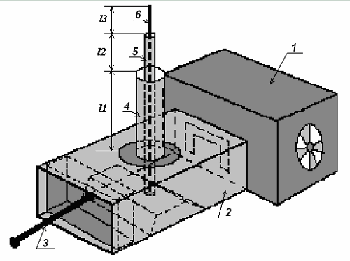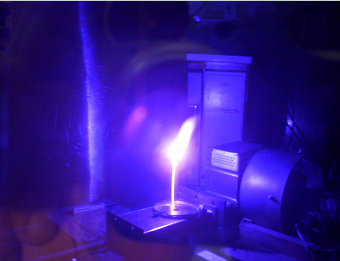

Copyright 2009 BigMax

Single-wire open line khown as Goubou line[1] is being intensely investigated for low loss electromagnetic power transmission in broad band from MHz up to THz. Long wave signals transmission in such line is considered as surface waves (also khown as Zommerfeld-Zennek wave) propagation. Such single-wire line is easy-to-use in experiment as transmission line for microwave discharge excitation on its end. Setup for microwave plasmoid excitation is presented in fig.1.

Fig.1 microwave unit: 1 - magnetron, 2 -cavity formed by waveguide segment with Н10 mode, 3 - plunger, 4 -coaxial line, 5 - inner conductor, 6 - Goubou line

Fig.2. Waveguide-coaxial design of microwave unit and discharge into the single-wire Goubou line end
Microwave discharge initiation on the Goubou line end propeties were investigated using microwave unit showed in fig.1. We considered Goubou line segment operation as a spike antenna of surface waves. This regime takes place when power input from magnetron is sufficient for a spontaneous microwave discharge on the line end - electrical field of electromagnetic wave is higher than threshold one. For it the inner coaxial line conductor was shortened by wide waveguide face that lead to strong feild inhomogeuinity in Goubou line end. waveguide-coaxial microwave unit design and discharge in single-wire Goubou line end is shown in fig.2.
The described microwave unit can be widely used together with plasmotrons based on use of microwave dicharge in varios gas medium. This device benefits are in microwave discharge high temperature (about 50000 С) and in the use of single-wire line providing high temperature source delivering in any given point. Nozzle absence in coaxial considerably increase design reliability. Metal conductor erosion can be applied as a new method of adhesive capable evaporation of refractory metals onto substrates.
Also Goubou line and high-temperature microwave torch discharge application is possible in oil industry, e.g. in utilization of the gas accompanied with oil добыче. Photo in the fig.3 shows combustion of gas (propane) transmitted to the microwave torch discharge through pipe formed by coaxial line inner conductor.
The described microwave unit can be widely used together with plasmotrons based on use of microwave dicharge in varios gas medium. This device benefits are in microwave discharge high temperature (about 50000 С) and in the use of single-wire line providing high temperature source delivering in any given point. Nozzle absence in coaxial considerably increase design reliability. Metal conductor erosion can be applied as a new method of adhesive capable evaporation of refractory metals onto substrates.
Also Goubou line and high-temperature microwave torch discharge application is possible in oil industry, e.g. in utilization of the gas accompanied with oil добыче. Photo in the fig.3 shows combustion of gas (propane) transmitted to the microwave torch discharge through pipe formed by coaxial line inner conductor.